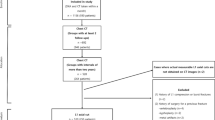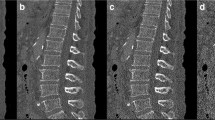Abstract
The number of participants in thoracic or abdominal examinations using multi-detector-row CT (MDCT) has been increasing recently. If the degree of progress of osteoporosis can be estimated using these images, it may be useful as it will allow predictions of vertebral fractures without an additional radiation exposure. The aims of this study were to investigate segmental variations in bone mineral density (BMD) distributions of thoracic and lumbar vertebral bodies and to show specific differences according to age and gender. A large database including 1,031 Japanese subjects for whom MDCT was used to examine various organs and tissues was utilized in this study for trabecular BMD at thoracic and lumbar vertebrae. In relationship to vertebral level, L3 had the lowest trabecular BMD. BMD tended to gradually increase from L3 to T1 in all age categories. Also, there was a moderate correlation between vertebrae whose distance from each other was great whereas there was a high correlation between adjacent vertebrae. It may be appropriate to use an arbitrary vertebra as a first approximation for assessing vertebrae that are in the area of predilection for the fracture; however, to better understand their behavior, it may be necessary to measure BMD directly in this region. This study showed trabecular BMD distribution at healthy thoracic and lumbar vertebrae in Japanese subjects and specific differences in age and gender. Improved knowledge about vertebral BMD may help with the diagnosis of primary osteoporosis using MDCT.







Similar content being viewed by others
References
McDonnell PM, McHugh PE, O’Mahoney D (2007) Vertebral osteoporosis and trabecular bone quality. Ann Biomed Eng 35:170–189
Bouxsein M (2003) Bone quality: where do we go from here? Osteoporos Int 14(suppl 5):118–127
Ito M, Ikeda K, Nishiguchi M, Shindo H, Uetani M, Hosoi T, Orimo H (2005) Multi-detector row CT imaging of vertebral microstructure for evaluation of fracture risk. J Bone Miner Res 20:1828–1836
Grote HJ, Amling M, Vogel M, Hahn M, Posl M, Delling G (1995) Intervertebral variation in trabecular microarchitecture throughout the normal spine in relation to age. Bone (NY) 16:301–308
Gong H, Zhang M, Yeung HY, Qin L (2005) Regional variations in microstructural properties of vertebral trabeculae with aging. J Bone Miner Metab 23:174–180
Hulme PA, Boyd SK, Ferguson SJ (2007) Regional variation in vertebral bone morphology and its contribution to vertebral fracture strength. Bone (NY) 41:946–957
Thomsen JS, Ebbesen EN, Mosekilde LI (2002) Age-related differences between thinning of horizontal and vertical trabeculae in human lumbar bone as assessed by a new computerized method. Bone (NY) 31:136–142
Chen H, Shoumura S, Emura S, Bunai Y (2008) Regional variations of vertebral trabecular bone microstructure with age and gender. Osteoporos Int 19:1473–1483
Eastell R (1998) Treatment of postmenopausal osteoporosis. N Engl J Med 338:736–746
Sawada K, Morishige K, Nishio Y, Hayakawa J, Mabuchi S, Isobe A, Ogata S, Sakata M, Ohmichi M, Kimura T (2009) Peripheral quantitative computed tomography is useful to monitor response to alendronate therapy in postmenopausal women. J Bone Miner Metab 27:175–181
Lenchik L, Shi R, Register TC, Beck SR, Langefeld CD, Carr JJ (2004) Measurement of trabecular bone mineral density in the thoracic spine using cardiac gated quantitative computed tomography. J Comput Assist Tomogr 28:134–139
Orimo H, Sugioka Y, Fukunaga M, Muto Y, Hotokebuchi T, Gorai I, Nakamura T, Kushida K, Tanaka H, Ikai T, Ohhashi Y (1998) Diagnostic criteria of primary osteoporosis. J Bone Miner Metab 16:139–150
Lu Y, Genant HK, Shepherd J, Zhao S, Mathur A, Fuerst TP, Cummings SR (2001) Classification of osteoporosis based on bone mineral densities. J Bone Miner Res 16:901–910
Bouxsein ML, Melton LJ 3rd, Riggs BL, Muller J, Atkinson EJ, Oberg AL, Robb RA, Camp JJ, Rouleau PA, McCollough CH, Khosla S (2006) Age- and sex-specific differences in the factor of risk for vertebral fracture: A population-based study using QCT. J Bone Miner Res 21:1475–1482
Sigurdsson G, Aspelund T, Chang M, Jonsdottir B, Sigurdsson S, Eiriksdottir G, Gudmundsson A, Harris TB, Gudnason V, Lang TF (2006) Increasing sex difference in bone strength in old age: the Age, Gene/Environment Susceptibility–Reykjavik study (AGES-REYKJAVIK). Bone 39:644–651
Singer K, Edmondston S, Day R, Breidahl P, Price R (1995) Prediction of thoracic and lumbar vertebral body compressive strength: correlations with bone mineral density and vertebral region. Bone (NY) 17:167–174
Weishaupt D, Schweitzer ME, DiCuccio MN, Whitley PE (2001) Relationships of cervical, thoracic, and lumbar bone mineral density by quantitative CT. J Comput Assist Tomogr 25:146–150
Yoganandan N, Pintar FA, Stemper BD, Baisden JL, Aktay R, Shender BS, Paskoff G, Laud P (2006) Trabecular bone density of male human cervical and lumbar vertebrae. Bone (NY) 39:336–344
Lu WW, Zheng Y, Holmes A, Zhu Q, Luk KD, Zhong S, Leong JC (2000) Bone mineral density variations along the lumbosacral spine. Clin Orthop Relat Res 378:255–263
Banse X, Devogelaer JP, Munting E, Delloye C, Cornu O, Grynpas M (2001) Inhomogeneity of human vertebral cancellous bone: systematic density and structure patterns inside the vertebral body. Bone (NY) 28:563–571
Cody DD, Goldstein SA, Flynn MJ, Brown EB (1991) Correlations between vertebral regional bone mineral density (rBMD) and whole bone fracture load. Spine 16:146–154
Tanno M, Horiuchi T, Nakajima I, Maeda S, Igarashi M, Yamada H (2001) Age-related changes in cortical and trabecular bone mineral status: a quantitative CT study in lumbar vertebrae. Acta Radiol 42:15–19
Ebbesen EN, Thomsen JS, Beck-Nielsen H, Nepper-Rasmussen HJ, Mosekilde L (1998) Vertebral bone density evaluated by dual-energy X-ray absorptiometry and quantitative computed tomography in vitro. Bone (NY) 23:283–290
Hayashi T, Zhou X, Chen H, Hara T, Fujita H, Yokoyama R, Kanematsu M, Hoshi H (2007) Investigation of bone mineral density at vertebral bodies in X-ray CT images. Trans Jpn Soc Med Biol Eng 45:256–266 (in Japanese)
Hayashi T, Zhou X, Chen H, Hara T, Fujita H, Yokoyama R, Kanematsu M, Hoshi H (2008) Investigation on the distribution of low bone-mineral-density locations at human vertebral trabecular bone from X-ray CT images. Trans Jpn Soc Med Biol Eng 46:451–457 (in Japanese)
Glisanz V, Boechat MI, Roe TF, Loro ML, Sayre JW, Goodman WG (1994) Gender differences in vertebral body sizes in children and adolescents. Radiology 190:673–677
Ito M, Hayashi K, Kawahara Y, Uetani M, Imaizumi Y (1993) The relationship of trabecular and cortical bone mineral density to spinal fractures. Invest Radiol 28:573–580
Smet AA, Robinson RG, Johnson BE, Lukert BP (1988) Spinal compression fractures in osteoporotic women: patterns and relationship to hyperkyphosis. Radiology 166:497–500
Briggs A, Wark J, Kantor S, Fazzalari N, Greig A, Bennell K (2006) Bone mineral density distribution in thoracic and lumbar vertebrae: an ex vivo study using dual energy X-ray absorptiometry. Bone (NY) 38:286–288
Hayashi T, Zhou X, Hara T, Fujita H, Yokoyama R, Kiryu T, Hoshi H (2006) Automated segmentation of the skeleton in torso X-ray volumetric CT images. In: Proceedings of the 20th international congress and exhibition of computer assisted radiology and surgery 2006, vol 1, pp 522–523
Cann CE, Cenant HK (1980) Precise measurement of vertebral mineral content using computed tomography. J Comput Assist Tomogr 4:493–500
http://www.r-project.org/. Accessed September 11, 2008
Bonjour JP, Theintz G, Law F, Slosman D, Rizzoli R (1994) Peak bone mass. Osteoporos Int 4(suppl 1):7–13
Compston JE (1995) Alimentary pharmacology therapeutics. Blackwell, Oxford, pp 237–250
Nishihara S, Koike M, Ueda K, Sanada T, Ebitani K, Kohama C, Sumida H, Iida T, Fujita H, Hara T (2003) Intra- and inter- equipment variations in the mean CT numbers of a vertebral body for X-ray CT equipment. Jpn Soc Med Imaging Inform Sci 20:40–43 (Japanese)
Rho JY, Hobatho MC, Ashman RB (1995) Relations of mechanical properties to density and CT numbers in human bone. Med Eng Phys 17:347–355
Ross PD, Fujiwara S, Huang C, Davis JW, Epstein RS, Wasnich RD, Kodama K, Melton LJ 3rd (1995) Vertebral fracture prevalence in women in Hiroshima compared to Caucasians or Japanese in the US. Int J Epidemiol 24:1171–1177
Acknowledgments
The authors thank members of the Fujita Laboratory for their valuable discussion and are grateful to Gifu University Hospital staff for preparing the CT cases, especially to Mr. T. Miyoshi and Mr. Y. Inoue. This research was supported in part by a research grant of Grant-in-Aid for Young Scientists B (21700462) from Japan Society for the Promotion of Science (JSPS), in part by a research grant from Japan Osteoporosis Foundation, in part by the Ministry of Health, Labor and Welfare under a Grant-In-Aid for Cancer Research, Japanese Government, and in part by a research grant of Grant-in-Aid for Scientific Research on Priority Areas (21103004) of the Ministry of Education, Culture, Sports, Science, and Technology, Japan.
Author information
Authors and Affiliations
Corresponding author
About this article
Cite this article
Hayashi, T., Chen, H., Miyamoto, K. et al. Analysis of bone mineral density distribution at trabecular bones in thoracic and lumbar vertebrae using X-ray CT images. J Bone Miner Metab 29, 174–185 (2011). https://doi.org/10.1007/s00774-010-0204-1
Received:
Accepted:
Published:
Issue Date:
DOI: https://doi.org/10.1007/s00774-010-0204-1




